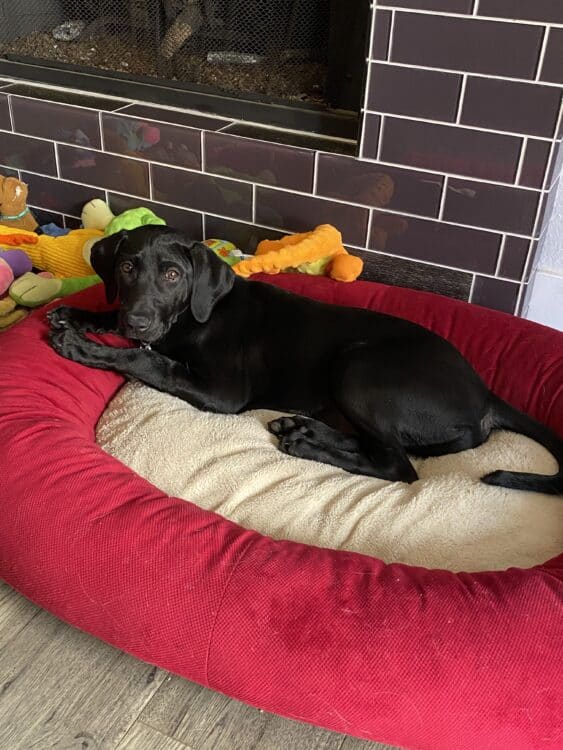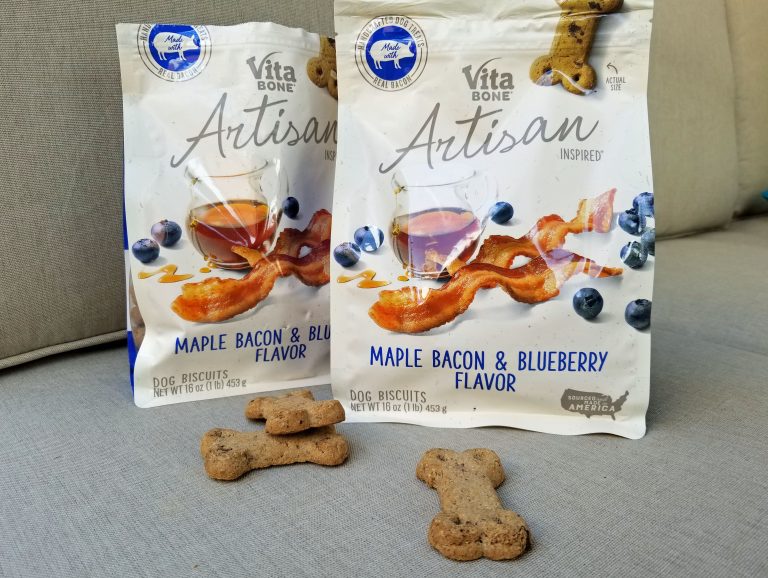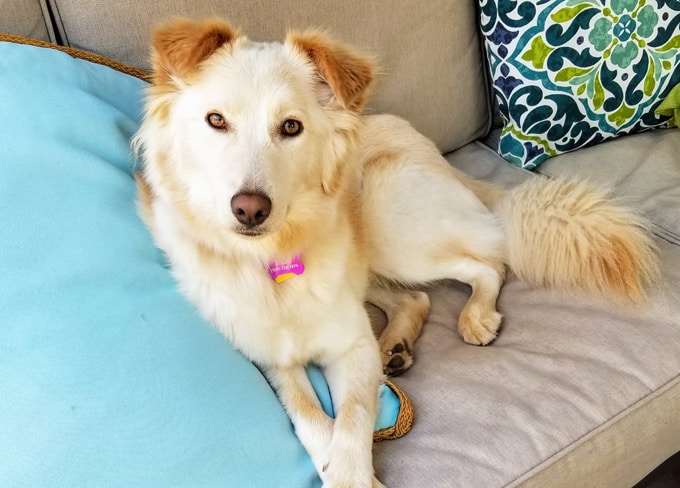Bringing Home a Puppy: Shopping for New Dog Supplies in Advance
Last week, we did a thing, a thing we’ve been talking about for several months: we got our dog a dog. I’ll introduce our gorgeous Lady Sif more fully in a dedicated post, but first, I’m sharing our tips on prepping for bringing home a puppy. Shopping for new dog supplies is a huge task but online shopping and a little planning makes it so easy.

When you’re first considering getting a dog, you have a lot of decisions to make, like what breed? Male or female? How old? Rescue or adopt? (That one’s easy. Rescue, always rescue.) After you take all the steps to secure the dog and bring it to your dog-safe home, you have one thing left to do: shop for dog supplies.

Dog Supplies to Buy Before Bringing Home a Puppy
- Leash
- Collar
- Harness
- Food
- Treats
- Training Treats
- Bed
- Toys
- Crate (if crate training)
- Poop Bags (for walks)
- Shampoo

Let’s break that list down a little more.
- Leash: there are a lot of different kinds, but puppies like to chew their leash, and it can be hard to pry it away from them until they learn the “leave it” command. (And they eventually no longer try to eat the leash at all.) Leather is the best way to go, and while it may cost a little more, dogs can’t chew through it. They also can’t rip like the typical nylon/fabric leashes can over time. There are also two different kinds of clasps: one is spring-loaded, where you have to use your thumb to hold it open before enclosing the loops of the collar, and the other is a piece of metal that opens when you apply pressure with the loop. Avoid that second one — they have a higher rate of opening in error when the dog turns its head and the loop leans against it, resulting in disconnection and boom, your dog’s got freedom. (Happened to me once and it was terrifying.) Take a look at Cherrybrook.com to find a leash that’s secure. Use code 10WALK to save 10% on leads through 5/31/23.
- Collar: there are so many different kinds, allowing you to find a collar that suits your dog’s temperament along with its personality. I’m not a fan of choke chain collars, or those with prongs, so I won’t be recommending any of those. I’ve use Martingale collars for training, but in the end, I rely on our dogs’ collars to hold tags and provide leash use in/around the house; others use them for walks and all leash needs, but that will depend on collar fit and the level of your dog’s readiness for leash training. Collars need to fit snugly, leaving room for two fingers between the collar and their neck. If they are too loose, dogs will slip out. I prefer a collar I can easily snap together. Reflective is a nice bonus, and I like something a little unique, in case I ever needed to explain my dog to someone. Be sure to measure your dog before you place an order. Also, check your dog’s fit regularly. Even a matter of a few days can result in a collar that’s too tight.
- Harness: first, to be clear, not everyone uses a harness, not even temporarily. However, for us, we feel far more confident until we get to know our dog and there is some recall ability. Harnesses can be very custom-fitted to prevent your dog from escaping, so take measurements before you purchase anything. Make sure you adjust each possible connection area for optimal fit. Our Golden-Border Collie escaped her first harness. Harnesses can be attached to a leash on the top/back or on the neck in the front. Having one that you can attach to the front can be the best when leash training. We use a harness like the one shown below this list; it’s comfortable, we can choose patterns/colors that we like and they offer a level of control that a collar doesn’t. In the end though, training is everything and gear is only an additional piece in the big picture
- Food: there are SO many choices. Talk to your vet. Consider your dogs’ breeds and ages. Price is very much a factor, so your budget will need to be considered. Dog food can be very expensive, but the cheaper foods may have some ingredients that aren’t optimal for your dogs’ health. Research and ask questions before you try, and if you can, buy a smaller portion before you drop $55 on a big bag that won’t get eaten. (But conversely, don’t give up after just a few meals; dogs can take several days to adjust to something new.) I have to reiterate though — talk to your vet. They will give you the proper way to change foods to prevent diarrhea and stomach upset for your pup. (Just like humans, if we ate only one thing and then suddenly switched to another, we’d get temporarily sick. Things need to be slowly transitioned.)
- Treats: there are more treats than I can ever mention, but you will need them on hand. Your dog will do something SO cute, you will want to reward them and give them all the cookies. Have some proper ones on hand, like these.
- Training treats: these are different than regular treats, because these will need to be used frequently, and if you use big treats for training, it takes too long for the dog to chew and empty their mouth and refocus. You want small, basic treats they can quickly chew and swallow, so you can move on. You also don’t want your dog going way above their recommended caloric intake, or you’ll have a new problem on your hands.
- Bed: even if you crate your dog at night, dogs lay in beds on cold mornings, for nappy dos (and puppies can sleep a LOT), or just when they’re taking a break. They are priced and sized all over the map, but dogs grow, so keep that in mind when you choose your first bed.
- Toys: just before I started writing this, I placed yet another toy order online. The new puppy continues to tear her way through Shuri’s toys, so I keep buying Shuri new toys AND replacing toys for Sif, as she has different toy needs and she is ripping through things in hours. Finding super chewer toys — toys that are durable and safe — can be hard. Bored dogs chew things they shouldn’t, so if you constantly have a safe dog toy available to replace for a bad behavior, your baseboards, shoes, furniture will ALL appreciate it. (Bu with those shoes — keep them and anything else out of their reach if it’s not safe for them to eat/chew. It saves your shoe budget and can help prevent a trip to the emergency vet. It happens, dogs can surprise us, but if we can minimize the risk, even better!)
- Crate: not everyone crates their dog, but it can be a great way to keep him/her safe, particularly at night. Our older pup (she’ll be three the end of July) was a rescue who was not crate-trained. By the time we got her, crate training was really hard. She was very anxious and would not stop trying to get out. We could have stuck with it, but we chose not to. Our new dog, who is 5 months old today, was already crate-trained. We only use it at night, and she happily goes in it, immediately plopping down. We could use it during the day if we wanted to, but so far, we haven’t. Crates come in a lot of sizes. You don’t want one too big, but if it’s too small, you’ll need to buy a bigger one as they grow. We cover it with a blanket at night, but you can purchase crate covers. We did buy a waterproof and chew proof cushion to go in the bottom. It protects her from cold floors and gives her a soft place to spend the night. We’d love to let her have a blanket in there, but that’s for after the chewing stage.
- Poop Bags: wherever your dog poops, you’ll need to pick it up and dispose of it properly, but when you’re taking it for walks, it may poop on the grass next to the sidewalk or wherever on your path. These tiny poop bags fit in your pocket and can be easily knotted until you find a trash can. (Trust me, the one time…the ONE TIME that you forget to carry it, the dog WILL poop and someone WILL see you. It’s not fun picking up a steamy pile but your neighbors will appreciate it.)
- Shampoo: you may not need this immediately, but unless you have puppy wipes, you will need some way to clean up a pup whose bottom gets too close to the ground as they are potty training. Some roll in mud. Others may vomit in excitement or nervousness in the car. Get some good, quality, safe shampoo so you aren’t desperately searching for a way to de-smell the pooch until you can get to the store. Use code 10WASH to save 10% on shampoos and conditioners through 5/31/23!

Bringing home a puppy is an amazing experience. We want to be able to focus on the puppy, so prepping in advance by making your home safe and having everything on hand will allow you to spend all your time snuggling and playing with that new sweet fur baby. One extra trip: cancel your plans for a few days, as much as you can. There will be plenty of time for you to be social later. Your pup will need you. You’ll work on potty training, calming and reassuring the puppy since its in a new space, and getting to know its personality. You’ll need to see what it does and doesn’t do, get a feel for its schedule, and get it on the right one. This can be hard if you’re all employed outside of the home, so try to tag team, or adopt when you know you have the best chance of it never being alone.
We chose last week for a couple of reasons. One, the kind of dog we were hoping for became available at a local rescue, and since we already have a dog, we have to be a little selective for her personality. And two, the husband just started a new job a few weeks ago and he’s currently unable to take vacation. This means we’ll be home, other than maybe a night or two on the weekends, and if we do that, our son will be here to take care of the fur babies. It’s also the hottest season of the year, so I’m home more; I hate the heat, my RA doesn’t like it, and my Disney pass is blocked, so I can easily open my schedule to be available. And I work at home, so I’m here anyway.

New dog supplies can be a decent outlay of cash initially, which is totally worth it, but be prepared. You can do it cost effectively and you can always buy what you need at the time and replace with different items later. Don’t let it stop you from adopting a puppy if you want it. Save, purchase in advance if possible, and plan. Bringing home a puppy can be in your future soon!

Looking for other dog-related content? Here’s our story of adopting a dog during quarantine, affordable dog supplies, caring for a dog with special needs, and national pet month!






